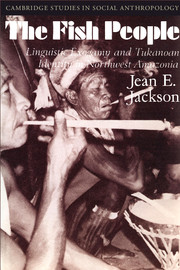Book contents
- Frontmatter
- Contents
- List of figures, maps, and tables
- Preface
- Acknowledgments
- Note on orthography
- 1 Purpose and organization of the book
- 2 Introduction to the Central Northwest Amazon
- 3 The longhouse
- 4 Economic and political life
- 5 Vaupés social structure
- 6 Kinship
- 7 Marriage
- 8 Tukanoans and Makú
- 9 The role of language and speech in Tukanoan identity
- 10 Male and female identity
- 11 Tukanoans' place in the cosmos
- 12 Tukanoans and the outside world
- 13 Conclusions: themes in Tukanoan social identity
- Notes
- Glossary
- References
- Index
- CAMBRIDGE STUDIES IN SOCIAL ANTHROPOLOGY
9 - The role of language and speech in Tukanoan identity
Published online by Cambridge University Press: 05 June 2012
- Frontmatter
- Contents
- List of figures, maps, and tables
- Preface
- Acknowledgments
- Note on orthography
- 1 Purpose and organization of the book
- 2 Introduction to the Central Northwest Amazon
- 3 The longhouse
- 4 Economic and political life
- 5 Vaupés social structure
- 6 Kinship
- 7 Marriage
- 8 Tukanoans and Makú
- 9 The role of language and speech in Tukanoan identity
- 10 Male and female identity
- 11 Tukanoans' place in the cosmos
- 12 Tukanoans and the outside world
- 13 Conclusions: themes in Tukanoan social identity
- Notes
- Glossary
- References
- Index
- CAMBRIDGE STUDIES IN SOCIAL ANTHROPOLOGY
Summary
It is by now obvious that language and speech are very important areas of Vaupés culture, among other things signaling identity in several social groups and categories. My choice of terminology for the exogamous language groups is based on the overwhelming importance of this factor in Tukanoan conceptualizations of these units. Although everyone is multilingual, individuals identify with and are loyal to only one language, their father language. Linguistic criteria are used as markers for differentiation among other kinds of social units as well – for example, sibs and phratries. In this chapter, I will examine in greater detail the ways in which language and speech are important to Tukanoans and will show how the Tukanoan model of language makes connections between linguistic phenomena and certain features of the nonlinguistic environment in which they occur.
In the Vaupés (as elsewhere), language and speech are used to communicate information in at least two ways. First, languages (and the various genres and registers of any given language) are codes that are used for exchanging referential information. Speakers intentionally use these codes to send messages to each other. Second, language and speech are codes for communicating – sometimes intentionally and sometimes totally unconsciously, social information about the identities of the speaker, interlocutor (the individual to whom the message is directed), and audience.
Tukanoans see language and speech as correlated with a number of features of Vaupés social organization and culture.
- Type
- Chapter
- Information
- The Fish PeopleLinguistic Exogamy and Tukanoan Identity in Northwest Amazonia, pp. 164 - 178Publisher: Cambridge University PressPrint publication year: 1983



